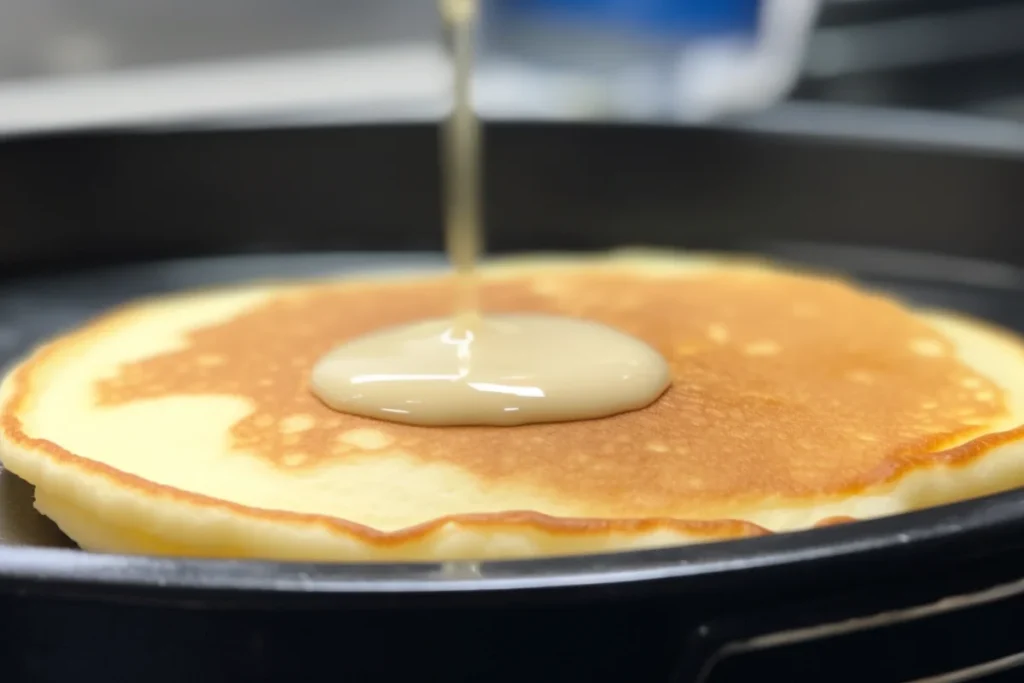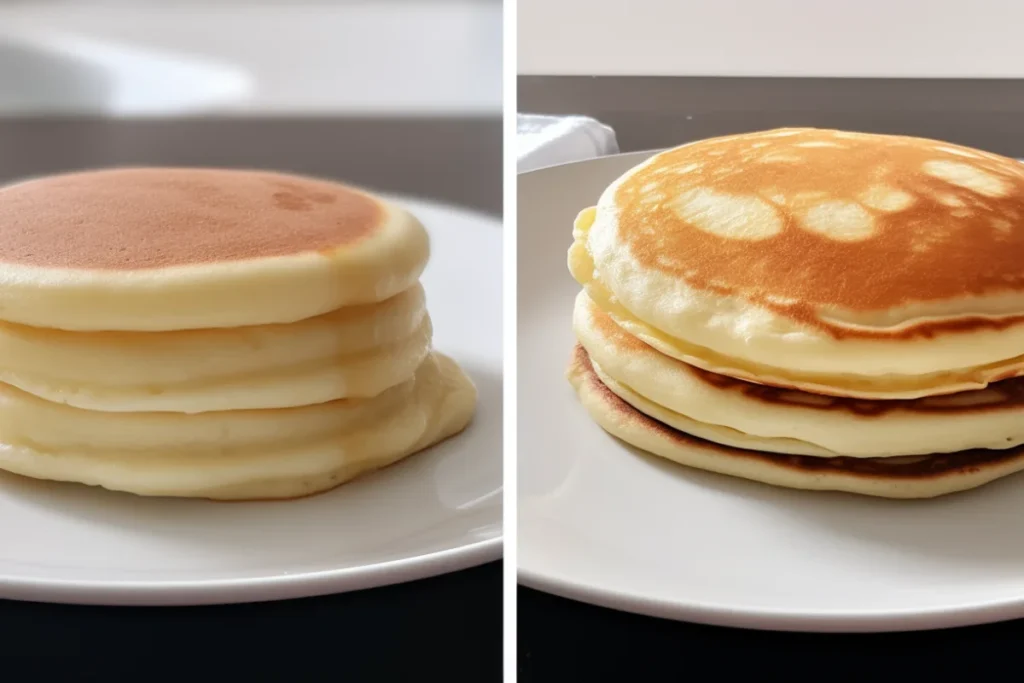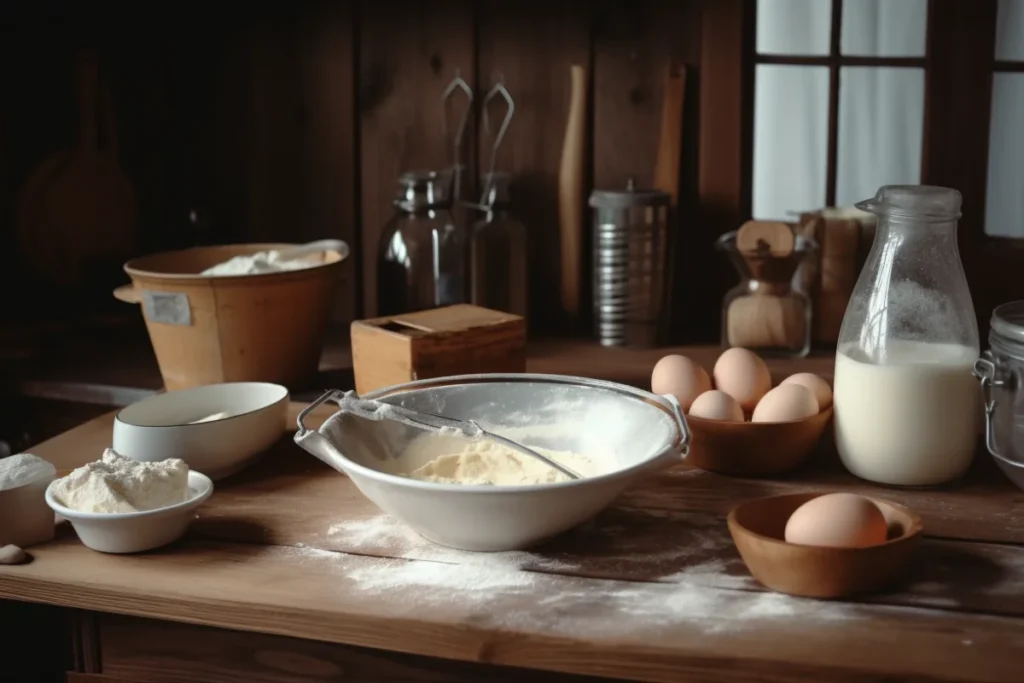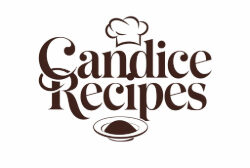Understanding Pancake Mix and Its Ingredients
Introduction
Pancakes, a beloved breakfast staple, have evolved over centuries from simple batter cakes cooked on hot stones to the fluffy delights we enjoy today. The invention of ready-made pancake mix revolutionized the way people prepared this dish, making it faster and more accessible.
Most pancake mixes are a combination of flour, sugar, baking powder (or soda), salt, and sometimes dried milk powder. These ingredients form the base, ready to be transformed into delicious pancakes with the addition of a liquid such as milk or water for Pancake mix. But which liquid works best? To answer this, let’s explore the components and science behind pancake batter.
If you’re interested in trying a classic homemade pancake recipe to compare with store-bought pancake mix, check out this Good Old-Fashioned Pancakes Recipe for a hands-on experience.
The Science Behind Pancakes

Liquid plays a pivotal role in pancake batter. It hydrates the dry ingredients, activates leavening agents, and helps create the desired texture and consistency. The amount and type of liquid can dramatically affect the outcome, influencing factors like fluffiness, taste, and moisture.
When combined with the leavening agents in the mix, liquid releases carbon dioxide gas, leading to the light and airy structure of pancakes. Milk or water? Each impacts the batter uniquely, providing distinct results in texture and flavor.
Milk and Its Properties
Milk, rich in proteins, fats, and natural sugars, adds depth to pancakes. It contains lactose, which browns during cooking, enhancing the pancake’s golden color and creating a slightly sweet undertone.
Nutritional Benefits of Milk in Pancakes:
- Protein: Adds structure to pancakes.
- Calcium: Supports bone health.
- Fats: Contribute to softness and richness.
Milk also brings a creamy texture, resulting in pancakes that feel indulgent and luxurious. However, milk-based batters might spoil faster, especially if left at room temperature for long.
Water and Its Properties
Water is a universal liquid—simple, calorie-free, and always available. While it lacks the nutritional complexity of milk, it serves as a neutral liquid for pancakes, focusing purely on hydration without altering the batter’s flavor.
Advantages of Using Water:
- No additional calories.
- Allows the pancake mix to retain its original flavor profile.
- Reduces the likelihood of spoilage in prepared batter.
Water-based pancakes might lack the creaminess and depth milk provides, but they’re perfect for those seeking simplicity or with dietary restrictions.
Common Types of Pancake Mixes
Not all pancake mixes are created equal. Some are designed to work better with milk, while others are crafted for flexibility with water. For instance:
- Buttermilk Pancake Mixes: Often recommend milk for that tangy, creamy taste.
- Whole-Grain Mixes: Blend well with water for a rustic, hearty flavor.
- Protein-Enhanced Mixes: Benefit from milk’s added protein for an extra nutritional boost.
Understanding your mix’s specific needs ensures a better pancake experience.
The Role of Dairy in Pancakes
Dairy ingredients like milk amplify the pancake’s flavor profile and softness. Milk proteins interact with the flour to create a tender crumb, while fats provide a silky richness. Furthermore, the lactose in milk promotes caramelization, giving pancakes their characteristic golden hue.
When additional ingredients like eggs, vanilla extract, or melted butter are used, milk complements and enhances these flavors, creating a harmonious taste.
Vegan Alternatives to Milk
For those avoiding dairy, plant-based milk alternatives can be a fantastic substitute:
- Almond Milk: Adds a subtle nutty flavor.
- Soy Milk: Offers a creamy texture similar to cow’s milk.
- Oat Milk: Provides natural sweetness and thickness.
These alternatives allow for similar results to traditional milk, making them ideal for vegan or lactose-intolerant cooks.
Pros and Cons of Using Milk
Milk undeniably enhances pancakes, but it’s not without its drawbacks.
Pros:
- Adds a rich, creamy flavor.
- Improves browning for a visually appealing result.
- Enhances texture and moisture.
Cons:
- Batter spoils faster when left unrefrigerated.
- May not be suitable for all dietary needs (e.g., lactose intolerance).
Pros and Cons of Using Water
While water simplifies the pancake-making process, it can produce less flavorful results.
Pros:
- Always available and easy to use.
- Keeps pancakes light and fluffy.
- Ideal for calorie-conscious eaters.
Cons:
- Results in blander pancakes.
- Doesn’t contribute to browning or richness.
Cultural Perspectives on Pancake Recipes
Globally, the choice of liquid in pancake batter often reflects local traditions:
- In France, milk is a staple in crepe recipes for its delicate texture.
- American pancakes often rely on buttermilk for their characteristic tanginess.
- In Asian cuisines, water-based batters are common for savory pancakes like okonomiyaki or scallion pancakes.
These cultural variations demonstrate that the choice between milk and water depends on the type of pancake and personal preferences.
Comparing Milk and Water in Pancake Mix
Texture Comparison
One of the most noticeable differences when using milk versus water in pancake batter is the texture.
- Milk-Based Pancakes: These are often fluffier and softer. The fats and proteins in milk create a tender crumb and contribute to a silky, smooth consistency in the batter.
- Water-Based Pancakes: These tend to be slightly denser. Without the added richness from milk, the texture is more basic and less indulgent.
This difference becomes even more pronounced when the pancakes are left to cool. Milk-based pancakes retain their moisture longer, while water-based ones may dry out more quickly.
Flavor Differences
Flavor is a key factor in choosing between milk and water.
- Milk: Its natural sugars and fats enhance the sweetness and provide depth to the pancake’s taste. Milk-based pancakes are richer and more flavorful, making them ideal for pairing with syrups, jams, or fruits.
- Water: As a neutral liquid, water lets the natural flavor of the pancake mix shine. This can be a positive for savory toppings but may leave sweet pancakes feeling bland without added flavoring.
For those seeking to elevate water-based pancakes, adding a splash of vanilla extract, a dash of cinnamon, or a pinch of sugar can help mimic milk’s flavor-enhancing qualities.
Visual Appeal

Milk and water also affect how pancakes look once cooked.
- Milk-Based Pancakes: The lactose in milk contributes to the Maillard reaction, which is responsible for the golden-brown crust that makes pancakes visually appetizing.
- Water-Based Pancakes: These often appear lighter in color due to the absence of milk sugars. While they can still brown, the effect is less pronounced.
If presentation is important, especially for breakfast gatherings or social media posts, milk may be the better choice.
Nutritional Impacts
From a health perspective, the choice of liquid can influence the nutritional profile of pancakes.
Milk:
- Adds calories, protein, fats, and essential nutrients like calcium and vitamin D.
- Can make pancakes more filling, which may help with portion control.
Water:
- Contains no calories, making it the choice for those on low-calorie diets.
- Doesn’t add any nutrients but keeps the recipe simple.
For a balanced option, consider using low-fat milk or unsweetened plant-based alternatives.
Cost Considerations
Cost is another factor that may guide the decision.
- Water: As a free and readily available option, water is budget-friendly and convenient.
- Milk: While not overly expensive, milk does add a cost, especially if you’re using specialty types like organic or non-dairy alternatives.
For large batches of pancakes or budget-conscious cooking, water might be the practical choice.
Compatibility with Add-Ons
The choice of liquid also influences how well pancakes pair with toppings.
- Milk-Based Pancakes: Their rich and creamy texture complements sweet toppings like syrup, whipped cream, or fruit compote.
- Water-Based Pancakes: These pair better with savory add-ons like eggs, bacon, or avocado, as their neutral flavor doesn’t clash with the toppings.
Experimenting with different toppings can help you discover what works best for your preferred liquid choice.
Experimenting with Ratios
Combining milk and water is another way to achieve a balanced outcome.
Tips for Mixing Ratios:
- A 50:50 ratio creates pancakes that are lighter than milk-only but more flavorful than water-only.
- For fluffier pancakes, use 75% milk and 25% water.
- To stretch milk without sacrificing flavor, a splash of water can help thin the batter without compromising richness.
Adjusting the liquid ratio allows for customization based on taste and texture preferences.
Shelf Life of Prepared Batter
The liquid you choose also affects how long pancake batter can be stored.
- Milk-Based Batter: Best used immediately or refrigerated for up to 24 hours. Milk can spoil if left out, especially in warm conditions.
- Water-Based Batter: More stable at room temperature and can last slightly longer in the fridge without risk of spoilage.
For meal prep, water-based batter might be more practical, but milk-based batter delivers superior taste when cooked fresh.
Practicality in Cooking Environments
Certain situations might dictate which liquid is more suitable.
- Camping or Outdoor Cooking: Water is often the more practical choice due to its availability and stability. Milk requires refrigeration, which may not be feasible.
- Home Cooking: Milk is easily accessible and enhances pancakes, making it ideal for home settings where storage and availability are not concerns.
Understanding the context of your cooking environment can help you make the right decision.
Audience Polls and Preferences
Surveys and polls among home cooks and chefs reveal divided opinions on the milk vs. water debate.
- Chefs’ Preferences: Many professional chefs recommend milk for its ability to enhance flavor, texture, and appearance.
- Home Cooks’ Insights: Water is favored for its simplicity and neutrality, particularly among those cooking for larger groups or with dietary restrictions.
Among pancake enthusiasts, the choice often comes down to personal taste and dietary needs.
Expert Recommendations and Practical Tips
Expert Chefs’ Opinions
Professional chefs often lean toward milk as the liquid of choice for pancakes due to its ability to enhance both flavor and texture. Chefs like Gordon Ramsay and Martha Stewart frequently advocate for the richness milk provides, especially in recipes designed for indulgence.
Why Chefs Prefer Milk:
- Milk contributes to a tender, moist texture.
- Its natural sugars promote a golden, appetizing crust.
- The creamy flavor profile complements additional ingredients like vanilla or butter.
For those seeking restaurant-quality pancakes, culinary experts recommend full-fat milk for its richness or buttermilk for added tanginess.
Nutritionists’ Views
Nutritionists take a more balanced approach, focusing on dietary goals and individual health needs. They highlight the benefits and potential downsides of both options.
Milk:
- Adds protein, calcium, and healthy fats, making pancakes more nutritious and filling.
- However, it also increases calorie content, which may not suit everyone’s dietary goals.
Water:
- A calorie-free option that simplifies the batter.
- Lacks the nutritional advantages of milk, but works well for those watching their intake.
For a middle ground, nutritionists suggest using plant-based milk alternatives or low-fat milk to maintain nutritional value without overloading on calories.
Tips for Beginners
If you’re new to making pancakes, choosing between milk and water can feel overwhelming. Here’s a simple guide to get started:
- Understand Your Priorities: If flavor and fluffiness are your goals, use milk. For quick and straightforward pancakes, opt for water.
- Experiment with Small Batches: Test both liquids in small amounts to see which suits your taste.
- Start Simple: Avoid adding too many extra ingredients at first. Focus on mastering the base batter.
As you gain confidence, you can begin experimenting with ratios and add-ons.
Customizing Pancakes for Specific Diets
Dietary restrictions don’t have to mean compromising on pancake quality. Here are some alternatives for common needs:
- Dairy-Free Options: Use almond, soy, or coconut milk to replicate the creaminess of traditional milk.
- Gluten-Free Pancakes: Choose gluten-free pancake mixes and pair them with any liquid of choice.
- High-Protein Variations: Use milk fortified with protein or add a scoop of protein powder to the mix.
Customizing your batter ensures everyone at the table can enjoy a stack tailored to their needs.
Enhancing Water-Based Pancakes
While water-based pancakes can feel plain, simple adjustments can elevate their flavor and texture.
Flavor Enhancers:
- Add vanilla extract or a pinch of cinnamon for aroma.
- Mix in a tablespoon of sugar or honey for sweetness.
Texture Boosters:
- Use sparkling water instead of regular water for a fluffier result.
- Incorporate melted butter or a splash of oil to mimic the richness of milk.
These tweaks help water-based pancakes rival their milk-based counterparts.
Experimenting with Milk Alternatives
Milk alternatives have gained popularity, offering unique flavors and textures.
- Almond Milk: Creates a nutty undertone and lighter batter.
- Soy Milk: A close match to traditional milk in creaminess and texture.
- Coconut Milk: Adds a subtle tropical flavor and works well in vegan recipes.
When using alternatives, note that some, like oat milk, are naturally sweeter, while others, like almond milk, may require added sweeteners.
Creating the Perfect Pancake Batter

A perfect pancake batter balances dry and wet ingredients to create a smooth, lump-free consistency.
Tips for Perfect Batter:
- Measure Accurately: Use the exact amount of liquid recommended on the pancake mix box.
- Mix Gently: Overmixing can lead to dense pancakes. Stir until the ingredients are just combined.
- Adjust Consistency: The batter should be thick enough to hold its shape but thin enough to pour easily.
For a unique twist, experiment with add-ins like blueberries, chocolate chips, or mashed bananas.
Cooking Techniques for Best Result
The way you cook your pancakes can make all the difference, regardless of the liquid used.
For Milk-Based Pancakes:
- Use medium heat to allow the pancakes to cook evenly without burning.
- Flip when bubbles form on the surface and the edges begin to set.
For Water-Based Pancakes:
- Preheat the pan to ensure even cooking.
- Use a non-stick surface or a light coating of butter to prevent sticking.
Cooking with precision ensures both milk and water-based pancakes turn out perfectly.
Case Studies from Pancake Enthusiasts
Many pancake lovers have conducted informal experiments, comparing milk and water in pancake batter.
Findings:
- Milk-Based Pancakes: Consistently ranked higher for flavor, texture, and visual appeal. Most preferred for brunch and special occasions.
- Water-Based Pancakes: Valued for their simplicity and practicality, particularly for camping or last-minute breakfasts.
These insights show that while milk is favored for indulgence, water holds its own as a versatile and convenient option.
Final Verdict
The choice between milk and water ultimately depends on personal preference and the situation:
- Use milk when flavor, richness, and presentation matter most.
- Opt for water when simplicity, practicality, or dietary restrictions take precedence.
For the best of both worlds, consider experimenting with a mix of the two liquids or incorporating milk alternatives to suit your specific needs. Pancakes, after all, are a canvas for creativity and customization!
FAQs
- Can I mix milk and water in pancake batter?
Yes, combining the two can balance flavor and texture. - What is the best non-dairy alternative for pancakes?
Soy milk or almond milk work well, depending on your preference for creaminess or nuttiness. - Does sparkling water make pancakes fluffier?
Absolutely! The carbonation adds extra lift to the batter. - What’s the recipe of Hotcake mix?
The recipe for a hotcake mix typically includes flour, sugar, baking powder, salt, and sometimes powdered milk, ready to combine with milk or water. - Can I use heavy cream instead of milk?
Yes, but you may need to dilute it with water to avoid overly thick batter. - What happens if I add too much liquid?
The batter will become too thin, leading to flat, unevenly cooked pancakes. - What to add to boxed pancake mix?
You can enhance boxed pancake mix by adding ingredients like vanilla extract, cinnamon, mashed bananas, blueberries, or a splash of milk for richer flavor and texture. - What’s the difference between a pancake and a hotcake?
The difference between a pancake and a hotcake is primarily regional terminology, though hotcakes are often slightly thicker and denser than pancakes. - What’s the shelf life of prepared pancake batter?
Milk-based batter lasts 24 hours in the fridge, while water-based batter can last slightly longer. - Is Hotcake mix the same as pancake mix?
Hotcake mix and pancake mix are essentially the same, with minor regional differences in name and sometimes slight variations in texture or sweetness.

